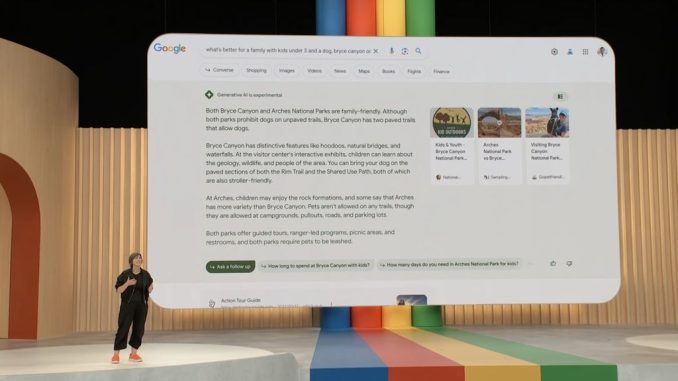
Google’s New Experimental Way to Search
Google has launched an experimental search engine that uses generative artificial intelligence (AI). The tech giant has long been an ‘AI-first’ company, with Microsoft and OpenAI as its leading competitors. Meanwhile, the search engine continues to be an essential part of Google, bringing in billions of advertising dollars annually. The company’s new Search Generative Experience feature generates answers to questions, supplemented by links to sites carrying information to support the response.
An Experiment that Connects you to Proof
In the traditional manner, upon inquiry, the familiar blue links appear with corresponding information blocks from Wikis and other sources that support the answer. However, in Google’s new eco-friendly Search Generative Experience feature, the answer first appears in a large field that subsequently occupies a significant portion of the search engine. The platform utilises an AI chatbot that provides multi-level answers, eliminating advertisements that are not relevant to the initial inquiry.
First in the US
The feature is available by invitation-only from users, and currently only users in the US can access it. Google has advised that the feature is still at the experimentation stage for standard questions, and the system determines the relevancy of the answer. Conversely, only traditional answers are given when responding to questions about health, finance, and other similar subjects. However, Google has explained that generative AI will be integrated into other company services, including office apps, and will compete with Microsoft on that front.
Revolutionizing Images and Photos
Google also introduced a Photoshop-like capability to their Photos app. This feature allows you to edit any image that is blurred or unclear, removing obstructed object perception by overlaying an image to complete it. This vastly improves the overall image quality, and the example Google presented of a baby holding balloons is testament to the potential of this new feature.
Google’s Catch-Up with Microsoft and OpenAI
Google’s catch-up is an essential step towards transitioning the company to the AI world. The tech company, known for its AI research, notably lagged during the launch of ChatGPT and Bard chatbots, leaving Microsoft and OpenAI to grab the lead. Still, this newest feature serves to remedy the previous failure, as Google sets its sights on becoming the top company in AI. Like ChatGPT, the search engine’s experimental version allows users to ask follow-up questions, but with a “jacket from Google” and no first-person aspect, thus not personalized.
Conclusion
Generative AI technology marks the new mainstay for companies, and Google seems to be leading the pack. As Google transitions to AI, it seeks to challenge its leading competitors Microsoft and OpenAI. What’s more, the company’s new Search Generative Experience feature and the Photos app’s editing capabilities serve to make it an even greater AI attraction.

Be the first to comment